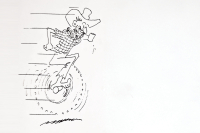Sales tax may be answer to HCC’s $70 million needs
By Julia Merchant • Staff Writer
In one room, a jagged crack runs from wall to wall, evidence of an unstable foundation. In another, the shifting earth has pushed one side of the floor higher than the other at a perceptible angle that causes objects to appear wildly off-kilter. Throughout the building, the roof sags and shows huge water spots. The occupants of the building attempt to alleviate the leakage by putting out 32-gallon containers in the attic when it rains.
A housing project? Nope. Welcome to the Mary Cornwell Production Crafts building of Haywood Community College. The facility houses one of the most esteemed arts programs in the country and hosts students from all over the nation who come to earn their degree in fibers, wood, metals and clay. The professional crafts program at HCC is credited with being the first that incorporated marketing and business alongside art.
The program is a source of pride for Western North Carolina and particularly Haywood County. The building it is housed in shouldn’t be.
“The students obviously don’t come because of the facilities,” chuckles department head Robert Blanton.
Growing serious, Blanton admits, “It’s not going to work for much longer.”
Related Items
HCC needs help — and its hoping voters will step up to the plate. After years of struggling to scrape together dollars to fund the college, local officials think they might have the answer in a quarter cent sales tax. If county commissioners agree to put the sales tax on the ballot, it will be up to voters in the upcoming election to approve it to help pay for much-needed projects at the college.
This past summer, every county in the state was given an option to increase its revenue stream. They could put either a real estate transfer tax or quarter cent sales tax on the ballot and seek voter approval to give the county another source of funding.
Neighbors for HCC
A group calling itself “Neighbors for Haywood Community College” is forming to push for the quarter cent sales tax.
“It’s our responsibility to keep up the facilities that we have at the community college, and our facilities are in dire need of upgrading,” explains chairman Larry Leatherwood. “We’re looking for the least intrusive way to generate some dollars to fulfill some needs that the college desperately has.”
The college is long overdue for an infusion of cash, admits Commissioner Mary Ann Enloe.
“They need a dedicated revenue stream. We’ve been looking for 10 years. The college has waited patiently while we’ve been able to do it for the public schools. It’s the college’s turn now.”
According to statutes governing community colleges, individual counties are expected to pay for facilities while the state pays operating costs. Right now the county gives HCC roughly $500,000 each year to cover maintenance on its buildings.
“The county commissioners have increased our maintenance budget substantially over the last few years, but it’s used for ongoing maintenance to existing facilities and there’s not much there to do renovation and new construction,” says Leatherwood.
“The money doesn’t go very far — it really doesn’t,” agrees HCC President Dr. Rose Johnson.
“We have buildings that are not functional and we have a significant amount of square footage that is not adequate for instruction, and with our enrollment and continued growth, we simply don’t have the amount or quality of space that our students need,” said Johnson.
The college’s needs grow more dire every year, and now total more than $70 million. There are so many, Johnson says, that it’s tough to say what should come first.
“We’ve got so many pressing needs we’re having some difficulty prioritizing items,” she said.
The professional crafts building is just one need of many. There’s the facility housing the popular cosmetic arts program, which will lose its license if the college doesn’t expand its instructional space by the fall of 2008. Then there is the Teaching and Learning Center and math lab, which currently operate in 400 square feet of space; a meeting space for clubs and organizations, which doesn’t currently exist; programs discontinued because they had nowhere to go after the 2004 floods wiped out facilities — and the list goes on.
Selling the tax
Supporters of the quarter-cent sales tax are trying to figure out the best way to convince voters to approve it. Officials hope voters will see the tax as fair with everyone sharing the burden.
“The sales tax affects everybody that spends any money. It’s a broad-based tax, and to me it’s just more fair,” says Enloe. “It isn’t going to hurt anybody much, and it’s going to be nominal as far as what it actually costs you.”
“We’re trying to develop some strategies as to how we’re going to get our message out that this is probably the least intrusive way to get money to do the $70 million in projected needs the community college has,” says Leatherwood. “Through the sales tax, not only do the citizens share in the opportunity, but our visitors who come in here and support our businesses would be making a contribution as well.”
Johnson hopes people will understand the crucial role the college plays in serving the public and helping the economy of Haywood County.
“We have graduates and students that represent almost every family and business organization in Haywood County. We’re part of the fabric that makes up the community,” she says.
Blanton sees firsthand how graduates of HCC benefit the local economy. He has students come from all over the country that complete the professional crafts program and settle in the area, selling their wares and putting money back into the community.
A success story
In the election this past November, 16 counties put the quarter cent sales tax on the ballot. It passed in five. One of those was Catawba County, where an overwhelming 80 percent of residents voted yes to the tax. Officials in Haywood County are looking to Catawba as an example of success to learn from.
There are several key reasons voters said yes to the tax, explains Catawba County Assistant Manager Lee Worsely. One is that from the get-go, commissioners threw their support behind it. Not only did they promise no increase in property taxes for three years in exchange for the sales tax, but they actively campaigned in the community, meeting with various groups and organizations.
“In my opinion, the commissioners did a really good job of getting the message out on specifically what the sales tax would be spent on,” Worsely says. In Catawba, the money was targeted for education, economic development, public safety and capital facilities.
“They were able to point to those specific items,” he said.
A group of local business leaders also pitched in on the effort by forming a political action group that raised money to promote the tax. The group put out television commercials and paid for mailings, emphasizing the premise of the sales tax as a fair way to get funding.
“We said it was fairer because everybody pays and you can kind of choose when you want to pay it. It also captures revenues from folks coming into Catawba,” Worsley said.
The county and the political action group played dual roles in helping the tax to pass.
“It was the staff giving facts and going out to community groups and promoting the message, and it was the work of the community group that actually promoted the sales tax.” said Worsley.
Additionally, “the Chamber endorsed it and newspapers wrote about it and did editorials in favor of it. It was really an effort by a lot of different people that pointed to us being successful.”
Meanwhile, Haywood Community College and its supporters are buckling down in preparation for a busy next few months trying to convince voters to say yes to the quarter cent sales tax. Until then, HCC will continue to serve students in substandard facilities.
On a recent afternoon, clay student Beth Cobb worked at a pottery wheel and chatted about improvements she’d like to see — a regulated heating system that doesn’t cause fragile pottery to crack, better ceilings and lighting, and adequate ventilation. And she had just one thing to say to Haywood County voters:
“Could you fix our school please?”









